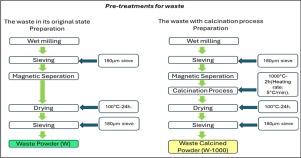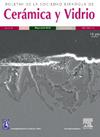Evaluation of the impact of Izmit Gulf bottom mud on the microstructure and technical properties of porcelain tiles
IF 2.7
4区 材料科学
Q1 MATERIALS SCIENCE, CERAMICS
Boletin de la Sociedad Espanola de Ceramica y Vidrio
Pub Date : 2025-08-23
DOI:10.1016/j.bsecv.2025.100458
引用次数: 0
Abstract
Recycling waste, using new potential local raw materials, and ecological practices have become necessary in today's world. This study added Izmit Gulf bottom mud waste as a replacement for clay in porcelain tile compositions at 5%, 10%, and 15% by weight (both in its natural form and its form calcined at 1000 °C). The samples sintered under industrial heating at 1220 °C were evaluated for firing shrinkage, density, green and fired flexural strength, and water absorption values and compared with standard porcelain tiles. Phase analysis was carried out using X-ray diffraction, and microstructural characteristics were examined using a scanning electron microscope. Notably, the samples containing 10% bottom mud showed green strength twice as high as the standard and a maximum fired strength of 85 MPa. X-ray diffraction revealed the formation of quartz, mullite, and sillimanite crystals in the waste-added samples. Calcination reduced the fluxing components and adversely affected rheology, making the natural form of waste more effective. At 15% addition, porosity increased, leading to deterioration in mechanical and physical properties. The A3 composition studied here is proposed as a promising alternative for producing a more sustainable, affordable, and environmentally friendly porcelain tile product.

伊兹米特海湾底泥浆对瓷砖显微结构和技术性能影响的评价
在当今世界,回收废物、使用新的潜在当地原材料和生态实践已成为必要。本研究添加了伊兹米特海湾底部的泥浆废物,作为瓷砖成分中粘土的替代品,其重量分别为5%、10%和15%(包括天然形式和1000°C煅烧形式)。在1220°C工业加热下烧结的样品进行了烧成收缩率、密度、生坯和烧成抗弯强度和吸水率的评估,并与标准瓷砖进行了比较。用x射线衍射进行物相分析,用扫描电镜检查微观结构特征。值得注意的是,含有10%底泥的样品的生坯强度是标准的两倍,最大燃烧强度为85 MPa。x射线衍射结果显示,废加样品中存在石英、莫来石和硅线石晶体。煅烧减少了助熔剂成分,对流变性有不利影响,使废物的自然形式更有效。当添加量为15%时,孔隙度增加,导致机械和物理性能恶化。本文研究的A3组合物被认为是生产更可持续、更经济、更环保的瓷砖产品的一种有前途的替代品。
本文章由计算机程序翻译,如有差异,请以英文原文为准。
求助全文
约1分钟内获得全文
求助全文
来源期刊

Boletin de la Sociedad Espanola de Ceramica y Vidrio
工程技术-材料科学:硅酸盐
CiteScore
5.50
自引率
2.90%
发文量
72
审稿时长
103 days
期刊介绍:
The Journal of the Spanish Ceramic and Glass Society publishes scientific articles and communications describing original research and reviews relating to ceramic materials and glasses. The main interests are on novel generic science and technology establishing the relationships between synthesis, processing microstructure and properties of materials. Papers may deal with ceramics and glasses included in any of the conventional categories: structural, functional, traditional, composites and cultural heritage. The main objective of the Journal of the Spanish Ceramic and Glass Society is to sustain a high standard research quality by means of appropriate reviewing procedures.
 求助内容:
求助内容: 应助结果提醒方式:
应助结果提醒方式:


